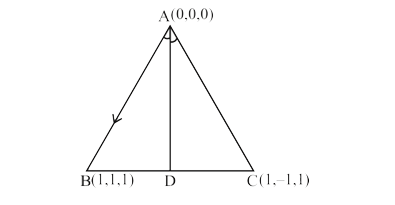If →a=ˆi+ˆj+ˆk & →B=ˆi−ˆj+ˆk are the sides of AB & AC of △ABC if AD is the angle bisector of ∠BAC where D lies on BC, then length of AD is
A
1
B
√2
C
√3
D
2
Video Solution
Text Solution
The correct Answer is:B

Let A is at origin then B(1,1,1) and C(1,-1,1) also AB=√3 AC=√3
Hence bisector theorem
BDDC=ABAC=1
∴D(1,0,1) ∴AD=√1+0+1=√2.
|
Updated on:21/07/2023
Similar Questions
Knowledge Check
- Question 1 - Select One
If →A=ˆi+ˆj+ˆkand→B=2ˆi+ˆj find
→A.→BA6B3C9D12 - Question 2 - Select One
If →A=3ˆi+ˆj+2ˆk and →B=2ˆi−2ˆj+4ˆk, then value of ∣∣→A+→B∣∣ will be
A8√2B8√3C8√5D5√8 - Question 3 - Select One
If →A=2ˆi+3ˆj−ˆk and →B=−ˆi+3ˆj+4ˆk then projection of →A on →B will be
A3√13B3√26C√326D√313
Given →a=ˆi−ˆj+ˆk and →b=2ˆi−4ˆj−3ˆk, find the magnitude of →b
View SolutionIf →A=ˆi+2ˆj+3ˆk and →B=ˆi+4ˆj−2ˆk then find (→A+→B)×(→A−→B).
View SolutionIf →A=9ˆi−7ˆj+5ˆk and →B=3ˆi−2ˆj−6ˆk then the value of (→A+→B).(→A−→B) is
View SolutionIf →a=2ˆi−3ˆkand→b=ˆi+4ˆj−2ˆk then →a×→b is
View SolutionIf →A=ˆi+2ˆj−ˆk,→B=−ˆi+ˆj−2ˆk , then angle between →Aand→B is
View Solution

